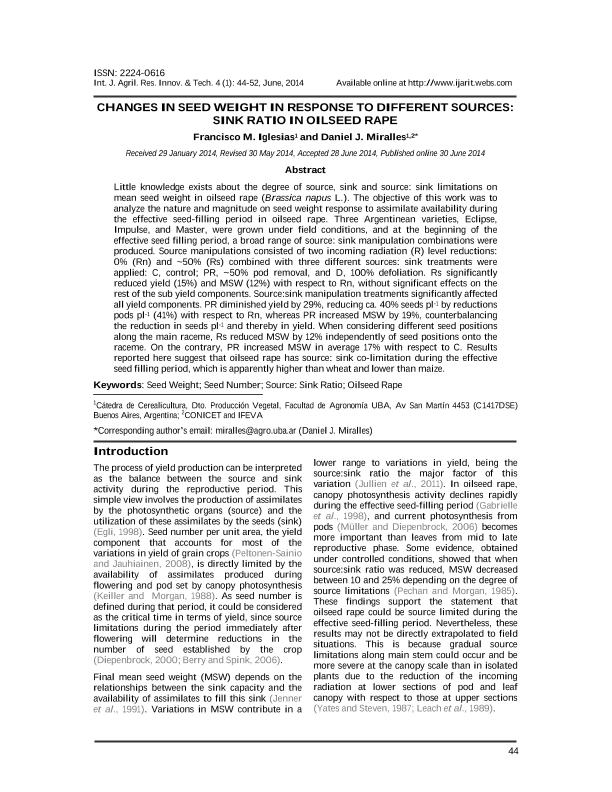Mostrar el registro sencillo del ítem
dc.contributor.author
Iglesias, Francisco Manuel

dc.contributor.author
Miralles, Daniel Julio

dc.date.available
2016-02-11T20:14:32Z
dc.date.issued
2014-09
dc.identifier.citation
Iglesias, Francisco Manuel; Miralles, Daniel Julio; Changes in seed weight in response to different sources: sink ratio in oilseed rape; IJARIT Research Foundation; International Journal of Agricultural Research, Innovation and Technology; 4; 1; 9-2014; 44-52
dc.identifier.issn
2224-0616
dc.identifier.uri
http://hdl.handle.net/11336/4163
dc.description.abstract
Little knowledge exists about the degree of source, sink and source: sink limitations on mean seed weight in oilseed rape (Brassica napus L.). The objective of this work was to analyze the nature and magnitude on seed weight response to assimilate availability during the effective seed-filling period in oilseed rape. Three Argentinean varieties, Eclipse, Impulse, and Master, were grown under field conditions, and at the beginning of the effective seed filling period, a broad range of source: sink manipulation combinations were produced. Source manipulations consisted of two incoming radiation (R) level reductions: 0% (Rn) and ~50% (Rs) combined with three different sources: sink treatments were applied: C, control; PR, ~50% pod removal, and D, 100% defoliation. Rs significantly reduced yield (15%) and MSW (12%) with respect to Rn, without significant effects on the rest of the sub yield components. Source:sink manipulation treatments significantly affected all yield components. PR diminished yield by 29%, reducing ca. 40% seeds pl-1 by reductions pods pl-1 (41%) with respect to Rn, whereas PR increased MSW by 19%, counterbalancing the reduction in seeds pl-1 and thereby in yield. When considering different seed positions along the main raceme, Rs reduced MSW by 12% independently of seed positions onto the raceme. On the contrary, PR increased MSW in average 17% with respect to C. Results reported here suggest that oilseed rape has source: sink co-limitation during the effective seed filling period, which is apparently higher than wheat and lower than maize.
dc.format
application/pdf
dc.language.iso
eng
dc.publisher
IJARIT Research Foundation
dc.rights
info:eu-repo/semantics/openAccess
dc.rights.uri
https://creativecommons.org/licenses/by-nc-sa/2.5/ar/
dc.subject
Rapeseed
dc.subject
Graini Weight
dc.subject.classification
Agricultura

dc.subject.classification
Agricultura, Silvicultura y Pesca

dc.subject.classification
CIENCIAS AGRÍCOLAS

dc.title
Changes in seed weight in response to different sources: sink ratio in oilseed rape
dc.type
info:eu-repo/semantics/article
dc.type
info:ar-repo/semantics/artículo
dc.type
info:eu-repo/semantics/publishedVersion
dc.date.updated
2016-03-30 10:35:44.97925-03
dc.journal.volume
4
dc.journal.number
1
dc.journal.pagination
44-52
dc.journal.pais
Bangladesh

dc.journal.ciudad
Moulvibazar
dc.description.fil
Fil: Iglesias, Francisco Manuel. Universidad de Buenos Aires. Facultad de Agronomía. Departamento de Producción Vegetal. Cátedra de Cerealicultura; Argentina
dc.description.fil
Fil: Miralles, Daniel Julio. Consejo Nacional de Investigaciones Científicas y Técnicas. Oficina de Coordinación Administrativa Parque Centenario. Instituto de Investigaciones Fisiológicas y Ecológicas Vinculadas a la Agricultura; Argentina. Universidad de Buenos Aires. Facultad de Agronomía. Departamento de Producción Vegetal. Cátedra de Cerealicultura; Argentina
dc.journal.title
International Journal of Agricultural Research, Innovation and Technology
dc.relation.alternativeid
info:eu-repo/semantics/altIdentifier/url/http://www.banglajol.info/index.php/IJARIT/article/view/21091
dc.relation.alternativeid
info:eu-repo/semantics/altIdentifier/doi/http://dx.doi.org/10.3329/ijarit.v4i1.21091
dc.relation.alternativeid
info:eu-repo/semantics/altIdentifier/issn/2224-0616
Archivos asociados
